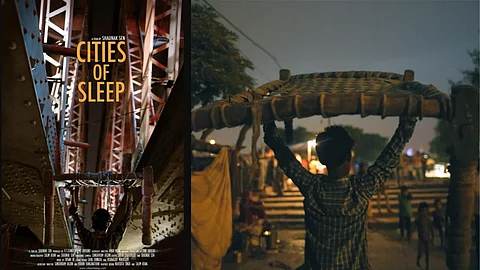
- HOMEGROWN WORLD
- #HGCREATORS
- #HGEXPLORE
- #HGVOICES
- #HGSHOP
- CAREERS
- ABOUT US
- CONTACT US

Sleep is a fundamental human need, but unfortunately, for the homeless population of Delhi, it's a luxury that's hard to come by. Vulnerable and marginalised, the homeless are looked at with contempt by the city’s urban residents and treated like an inconvenience by law enforcers. In a city where development takes precedence, the homeless are left to fend for themselves and struggle to find a safe place to rest their heads.
Oscar-nominated filmmaker and director Shaunak Sen delves into the politics and commodification of sleep in his first full-length documentary 'Cities of Sleep' released in 2015. Shot over two and a half years, the documentary explores the challenges of finding a safe and undisturbed place to sleep for the homeless population around Loha Pul and Meena Bazaar in Delhi, where resources are scarce. Sen's direction trails behind the continuous and uninterrupted series of events that shape the lives of those who plan their days around finding a spot to rest. With unbroken takes and poignant documentary footage, Cities of Sleep enters the world of Delhi’s ‘sleep mafia’ and ‘sleep communities’.
In the documentary, Shakeel, a homeless beggar, is shown struggling to secure a place in a sleep shelter located in the Meena Bazaar area of Old Delhi. Jamaal controls the shelter, which is built on government-allotted land and provides protection to those sleeping there. However, the documentary reveals that Shakeel is, in fact, a Hindu man named Manoj who had to adopt a Muslim name to increase his chances of finding a place in this predominantly Muslim shelter. Manoj is an outcast on many levels, but the film depicts his relentless efforts to find a safe place to rest and escape the harsh winter rains in Delhi. While Shakeel may not be the most likeable character, the documentary shows his desperation and struggle to secure a much-needed bed for the night.
On the other hand, the documentary also sheds light on a thriving sleep community that has made a home under the Loha Pul bridge in Delhi. The winding tunnels above this thin strip of land provide a much-needed relief from the blistering heat of the city. Ranjit, who runs the community, initially set up a cinema for people to visit at a nominal rate. However, he soon realised that people used the space to lounge and nap during the day. The community that formed around sleep serves as a social facilitator, but it is not without its own set of problems. The police often disrupt the community's routine, and the nearby Yamuna river poses a threat of flooding during the monsoon season. Despite the challenges, this community has found a way to thrive and create a sense of belonging for those who regularly visit.
Cities of Sleep takes a close look at the privilege associated with sleep in all its different forms. Jamaal runs a tight ship on public land, where the stakes are high, since his business relies on it. Meanwhile, Ranjit runs something closer to an NGO, providing a safe haven for those who are impoverished. This juxtaposition reflects the way that Delhi transforms at night to accommodate sleep shelters, completely changing the city's character during the day.
Shaunak Sen's cinematography captures the gritty, chaotic nature of the sleep economy in Delhi. The constantly shifting landscape is never fully secure and is, for many, a luxury that they cannot afford. Despite this, Sen's aesthetic eye lends an artistic and philosophical quality to the documentary, making it a visually stunning exploration of a complex and often overlooked issue.
If you enjoyed reading this, here's more from Homegrown:
A Homegrown Documentary Photoseries Capturing The Lives Of Karnataka's Fisherwomen
Watch A Zakir Hussain Narrated Documentary Tracing The Legacy Of Indian Classical Music
Where Children Sleep: Portraits Which Capture The Lives Of Children Around The World
